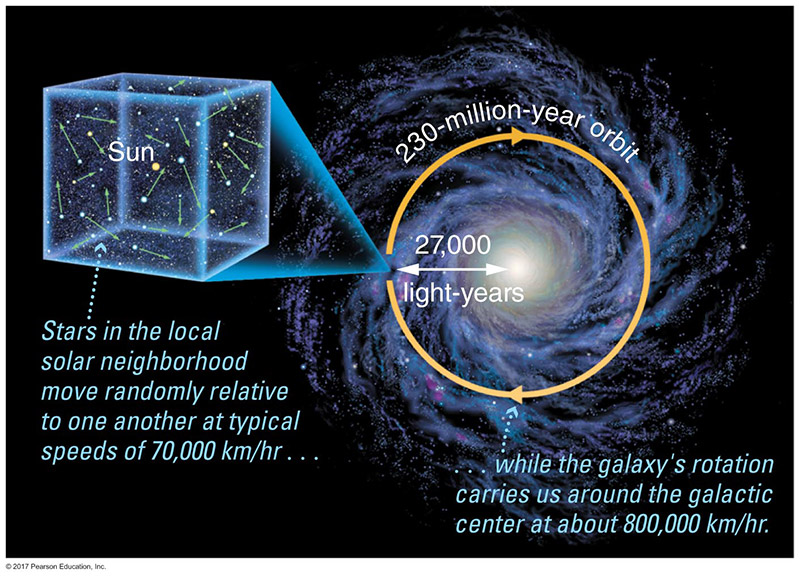Rotation and orbit are only a small part of the travels of spaceship Earth. We also have two major motions within our Milky Way Galaxy, both shown in Figure 1.30.

First, if you look in any small region of the galaxy, such as the box drawn in Figure 1.30 to represent our “local solar neighborhood,” you’ll find that stars move essentially at random relative to one another. Scientists can measure the speeds at which stars are moving, and they are quite impressive; on average, nearby stars are moving relative to us at about 70,000 kilometers per hour.
Given these high speeds, you might wonder why we don’t see stars racing around the sky. The answer lies in their vast distances. You’ve probably noticed that a distant airplane appears to move through the sky more slowly than one flying close overhead. Stars are so far away that even at speeds of 70,000 kilometers per hour, their motions would be noticeable to the naked eye only if we watched them for thousands of years. That is why the patterns in the constellations seem to remain fixed. Nevertheless, in 10,000 years the constellations will be noticeably different from those we see today. In 500,000 years they will be unrecognizable. If you could watch a time-lapse movie made over millions of years, you would see stars racing across the sky.
Video
The motion of two million stars
This video shows how the stars in our sky will move over the next 5 million years, based on measurements made by the European Space Agency’s Gaia spacecraft. Although the motions are substantial over millions of years, they are too gradual for us to notice on the time scale of human civilization, which is why the constellations still look essentially the same to us today as they did to our ancestors a few thousand years ago. Credit: European Space Agency.
Journal Entry
Spaceship Earth
Return to your journal page for “Spaceship Earth,” and add two new entries:
- Do you still agree with your previous answer to the question of “Does the Sun really rise and set each day?” Write a couple of sentences explaining why or why not.
- Based on what you’ve learned, do you think it makes sense to think of Earth as a “spaceship”? Write a paragraph or two explaining why or why not.
The second motion is rotation of the entire galaxy, which means that all stars orbit the galaxy’s center. As Figure 1.30 shows, our solar system orbits the galaxy at a speed of about 800,000 kilometers per hour. But the galaxy is so huge that even at this speed, it takes about 230 million years for our solar system to complete a single orbit.
Wow Factor
Dark Matter
Do the Math
Speed Around the Galaxy
How fast are we traveling with our solar system in its orbit around the center of the Milky Way Galaxy?
Step 1 Understand: This is another how fast question, so the answer is a speed that we will find by dividing a distance by a time. In this case, the distance is the circumference of our solar system’s orbit around the galaxy and the time is the time it takes to complete one orbit:

The data we need are shown in Figure 1.30: The radius of this orbit is 27,000 light-years and the time it takes to complete one orbit is 230,000,000 years.
Step 2 Solve: We put in the numbers and carry out the calculation on a calculator, while also converting light-years to kilometers (using the fact we found earlier, that 1 light year = 9.46 trillion km) and 1 year into hours, so that we’ll end up with units of km/hr:

Step 3 Explain: We’ve found that we are orbiting the center of the galaxy at a speed of about 790,000 kilometers per hour, which we can further round to 800,000 kilometers per hour. This is considerably faster than any spacecraft that humans have ever built (the fastest of which travel at about 50,000 kilometers per hour). That’s another reason why the idea of “spaceship Earth” makes a lot of sense.